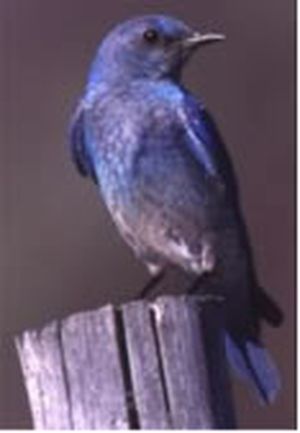Arriving bluebirds search for housing; you can help
WILDLIFE WATCHING -- Birders are spreading word daily of spring arrivals to the Inland Northwest and bluebirds are some of the most delightful to the eye.
The Idaho Fish and Game Department says the public can help make up for the loss of dead trees bluebirds and other cavity nesting birds need for pulling off broods this season by putting up bird nesting boxes in appropriate areas.
The department and offers volunteer-built bluebird houses for a donation of $5 at the Coeur d'Alene office, 2885 W. Kathleen Ave., as well as detailed plans for people who'd like to build their own bluebird boxes to the specific dimensions that have been found to be best for the birds.
- Any nest boxes that already have been put up in a previous year should be cleaned out now in preparation of this year's arrivals.
Studies have shown that bluebirds are already looking for nest sites and are most likely to adopt a nest box that's in place by late March. However, some of the birds will be looking for nest sites as late as mid-May, says Phil Cooper, IFG spokesman for the Panhandle.
Two species of bluebirds live in Idaho: the western bluebird and the mountain bluebird, which is Idaho's state bird. Both are slightly smaller than robins.
Thoreau said, "the bluebird carries the sky on his back," Cooper said, noting that the males of all the North American bluebird species sport brilliant blue backs.
- The mountain bluebird male has a very bright blue back and is pale blue below. The female is mostly gray with a trace of blue on the wings and tail. Mountain bluebirds are larger than western bluebirds.
- The western bluebird is less brightly colored. Males and females both have rust on the breast.
Read on for more details about bluebirds and bluebird nest boxes in this region:
Says Cooper:
Bluebirds live throughout Idaho in high desert juniper and mahogany, in forest meadows, and valleys and ridges in mountainous regions. They are most common at elevations of 4,000 feet and higher.
Bluebirds are ground feeders with grasshoppers being a favorite food. They also consume beetles, anst, wasps, caterpillars, crickets and even berries.
The bluebird's bill is not suited for creating nest cavities, so they make their nests in existing cavities excavated by woodpeckers or other animals. Nests are lined with grass, fine strips of bark and pine needles.
Bluebirds return to Idaho from their wintering grounds in the southwestern U.S. by late February or early March and seek tree cavities for nesting. Since many trees with suitable nesting holes have been cut for firewood, cleared to make way for development or have been occupied by non-native starlings or house sparrows, some bluebirds do not nest because they do not find suitable homes.
Man-made nest boxes help to fill the shortage of natural nest sites. Many Idahoans have already discovered the fun and satisfaction of building, placing and monitoring bluebird nest boxes.
The Panhandle Region office of the Idaho Department of Fish and Game (IDFG) has long been involved in coordinating the construction and distribution of bluebird nest boxes. School and civic groups have worked together to build boxes for people interested in providing our native, state bird with a place to nest and raise young.
IDFG Volunteers have built bluebird nest boxes which are now available at the Idaho Fish and Game office, 2885 W Kathleen Ave. in Coeur d’Alene. We are asking for a donation of $5 per bluebird box to cover the cost of wood and fasteners to put them together..
We also have a pamphlet called "Building Homes for Idaho's Bluebirds" available free of charge at our office. This contains plans for constructing boxes if you choose to make your own. There is also important information about how and where to place boxes so they are likely to successfully produce bluebirds. You can pick one up at the IDFG office when you get your boxes, or, call us and we can email it to you.
If you already have bluebird boxes installed on your property, it is important to clean them out now in preparation for the next nesting season. The brochure includes information on how to monitor and maintain boxes.
Since boxes have the greatest likelihood of being used the first year if placed by late-March, pick this publication up as soon as possible if you plan to build your own boxes. However, because bluebirds may move into boxes as late as mid-May, placement by then could allow boxes to still be used this year by late nesters.
